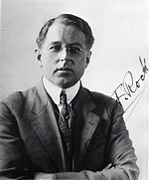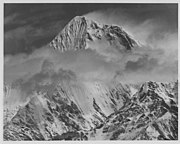|
Mount Gongga
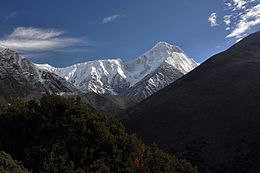  Mount Gongga (simplified Chinese: 贡嘎山; traditional Chinese: 貢嘎山; pinyin: Gònggá Shān), also known as Minya Konka (Khams Tibetan: མི་ཉག་གངས་དཀར་རི་བོ་, Khams Tibetan pinyin: Mi'nyâg Gong'ga Riwo) and colloquially as "The King of Sichuan Mountains", is the highest mountain in Sichuan province, China. It has an elevation of 7,556 m (24,790 ft) above sea level. This makes it the third highest peak in the world outside of the Himalaya/Karakoram range, after Tirich Mir and Kongur Tagh, and the easternmost and most isolated 7,000-metre (23,000 ft) peak in the world. It is situated in the Daxue Shan mountain range, between Dadu River and Yalong River, and is part of the Hengduan mountainous region. From it comes the Hailuogou glacier. The peak has large vertical relief over the deep nearby gorges. Mountaineering historyThe first western explorers in this region heard reports of an extremely high mountain and sought it out. An early remote measurement of the mountain, then called Bokunka, was first performed by the Inner Asian expedition of the Hungarian count Béla Széchenyi between 1877 and 1880.[1] That survey put the altitude of the peak at 7,600 metres (24,900 ft). Forty-five years later, the mountain, this time called Gang ka, was sketched by China Inland Mission missionary James Huston Edgar from a distance. In 1929 the explorer Joseph Rock, in an attempt to measure the mountain's altitude, miscalculated its height as 30,250 ft (9,220 m) and cabled the National Geographic Society to announce Minya Konka as the highest mountain in the world.[1] This measurement was immediately viewed with suspicion, and the Society's decision to check Rock's calculations before publication was well-founded. Following discussions with the Society, Rock reduced his claim to 7,803 m (25,600 ft) in his formal publication. In 1930 Swiss geographer Eduard Imhof led an expedition that measured the altitude of the mountain to be 7,590 m (24,900 ft).[2] A richly illustrated large-format book about the expedition was eventually published by Imhof, Die Großen Kalten Berge von Szetchuan (Orell Fussli Verlag, Zurich, 1974). The book includes many color paintings by Imhof, including images of the Tibetan monastery at the foot of the sacred mountain. The monastery was almost completely destroyed during the Cultural Revolution, around 1972–74. A properly equipped American team composed of Terris Moore, Richard Burdsall, Arthur B. Emmons, and Jack T. Young returned to the mountain in 1932 and performed an accurate survey of the peak and its environs. Their summit altitude measurement agreed with Imhof's figure of 7,590 m (24,900 ft). Moore and Burdsall succeeded in climbing to the summit by starting on the west side of the mountain and climbing the Northwest Ridge. This was a remarkable achievement at the time, considering the height of the mountain, its remoteness, and the small size of the group. In addition, this peak was the highest summit reached by Americans until 1958 (though Americans had by that time climbed to higher non-summit points). The book written by the expedition members, Men Against The Clouds,[3] remains a mountaineering classic. In May 1957 a Chinese mountaineering team claimed to have climbed Minya Konka via the Northwest Ridge route established by Moore and Burdsall. Six people reached the summit with limited climbing experience and primitive equipment, although four climbers died in the effort.[4] For political reasons, this region of China was made inaccessible to foreign climbers after the 1930s. In 1980 the region was again opened to foreign expeditions. American Lance Owens was the first foreigner to receive permission from the People's Republic of China to lead a mountaineering expedition in China and Tibet, allowing him to climb Gongga Shan (Minya Konka) in 1980. This expedition opened the modern era of American climbing in China. The expedition, organized by Owens and sponsored by the American Alpine Club, attempted the still unclimbed and extremely technical west face of Minya Konka. Members of the expedition included Louis Reichardt, Andrew Harvard, Gary Bocarde, Jed Williamson, and Henry Barber.[5] 
Deaths on the mountainA large number of mountaineering deaths have occurred on Gongga Shan, which has earned a reputation as a difficult and dangerous mountain. While the first ascent route up the Northwest Ridge appears technically straightforward, it is plagued by avalanches due to the mountain's highly unpredictable weather. During the 1957 Chinese ascent of the peak, four of nine climbers died. In 1980 an American climber died in an avalanche on the Northwest Ridge route.[7] In an unsuccessful 1981 attempt on the peak, eight Japanese climbers died in a fall.[8][9] As of 1999, more climbers had died trying to climb the mountain than had reached the summit.[10] As of 2003, the mountain had been successfully climbed only eight times.[9] In total, 22 climbers had reached the summit and 16 climbers had died in the effort. (These statistics may not take into account the four Chinese climbers killed in the 1957 expedition.) The Himalayan Index lists five ascents of Gongga Shan between 1982 and 2002, and about seven unsuccessful attempts.[11] There have been several attempts in years since then, which are unlisted in this index. In October 2017, Chinese media reported that Pavel Kořínek, a Czech national, had reached the top of Gongga Shan, marking the first time since 2002 that the mountain had been successfully climbed.[4] The article summarized the climbing history of Gongga Shan (Minya Konka) as follows:
References
Further reading
External linksWikimedia Commons has media related to Minya Konka. |
||||||||||||||||||||||||||||||
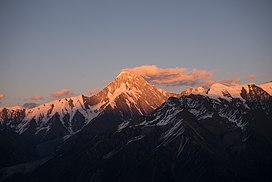
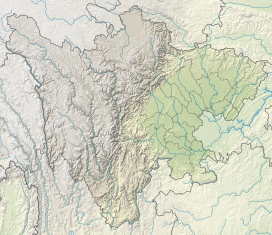
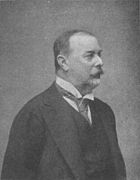
![Title page of an expedition report from a member of Graf Béla Széchenyi's expedition[6]](http://upload.wikimedia.org/wikipedia/commons/thumb/0/0e/UB_Maastricht_-_Kreitner_1881_-_title_page.jpg/122px-UB_Maastricht_-_Kreitner_1881_-_title_page.jpg)
